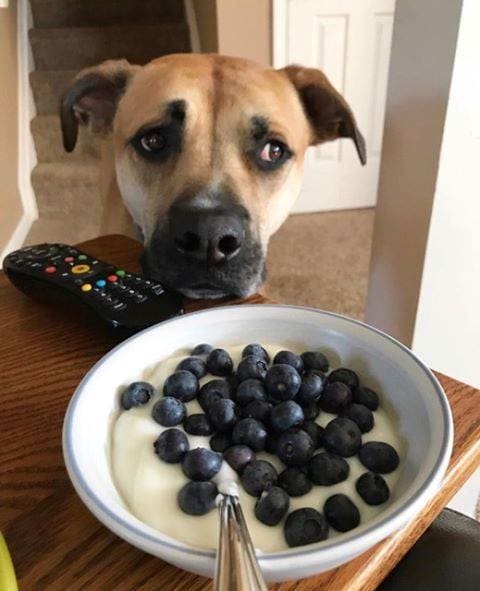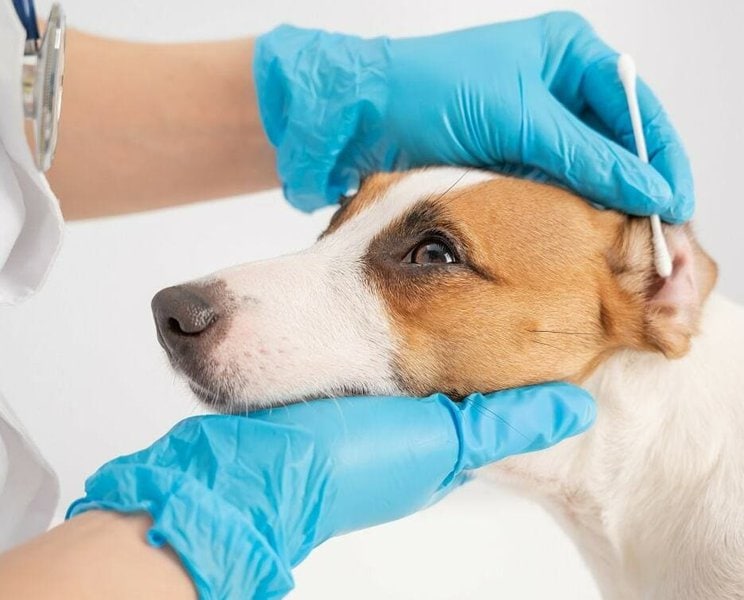Ear infections are one of the medical issues that are commonly observed in dogs. And as a dog owner, there is no need to fret, as ear infections are completely treatable.
The ability to identify symptoms is key to cleaning a dog’s ear infection and also to prevent the infection from degenerating into a more severe medical condition. That said, symptoms that are commonly observed when a pooch is suffering from ear infections include inflammation of the ear, fluid discharge from the ear, and a putrid odor.
The causes of canine ear infections vary, and they range from something that’s seemingly harmless, like the pooch’s diet, to a parasitic infestation and to the presence of foreign objects in the pooch’s ears. This article contains everything you need to know about canine ear infections, including treatment costs and the dangers of leaving this medical condition untreated.
However, before we go into all this, let’s take a look at some of the available treatment methods for canine ear infections.
How Do You Treat A Dog’s Swollen Ear?
You can treat a dog’s swollen ear at home with apple cider vinegar, coconut oil, hydrogen peroxide, probiotic supplements and Benadryl. Tea tree oil can also be an effective remedy to a dog’s swollen ear, but it has to be properly diluted before use.
Apple Cider Vinegar And Water
One of the most commonly used natural methods of treating a dog’s swollen ear is an appropriately prepared solution of apple cider vinegar and water.
Apple cider vinegar has acidic properties that make the ear inhabitable for yeast to thrive, thereby helping to reduce itching and inflammation of the ear caused by infection.
To prepare a mixture of vinegar and water to be used in treating your dog’s swollen ear:
- Mix apple cider vinegar and water in the ratio of 1:1; That is, one tablespoon of water to one tablespoon of vinegar.
- Soak the mixture in a cotton ball, and gently clean the exposed areas of the pooch’s ears.
- To clean the insides of the dog’s ears, squirt the mixture into the dog’s ear canal, and gently massage the pooch’s ears from the outside.
Coconut Oil
Another natural remedy that is equally as effective at treating a dog’s swollen ear is a mixture of coconut oil with garlic cloves.
Coconut oil has mild antifungal properties, and these can be quite effective at combating yeast, and subsequently taking care of the swelling that typically accompanies an ear infection.
To prepare a coconut oil remedy for your fido’s swollen ear:
- Simmer a mixture of two tablespoons of coconut oil and two whole garlic cloves in a saucepan.
- You should allow the mixture to simmer till the coconut oil becomes thin, and then give the mixture adequate time to cool before application.
- Apply two or three drops of the resulting liquid solution to the affected portions of the dog’s ear canal.
- Gently massage the base of the infected ear and clean out the insides with a cotton ball.
Hydrogen Peroxide
When it comes to treating dog ear infections, hydrogen peroxide works in similar fashion to apple cider vinegar by making the ear inhabitable for bacteria and mites.
However, hydrogen peroxide is acidic, and its use in cleaning dog ears is a controversial topic. Regardless, if you’re to apply hydrogen peroxide in cleaning your pooch’s ears, the mixture should be properly diluted and applied in moderation.
A mixture of one cup of lukewarm water and two tablespoons of hydrogen peroxide is safe to use on your dog. And you should apply four to five drops of this mixture in the infected ear, using a liquid dropper.
Thereafter, you should massage the base of the infected ear for about thirty seconds. And once the earwax responsible for the swelling has loosened up, clean it out with clean tissue wipes or a cotton ball.
Benadryl
Benadryl is a common, over-the-counter medication that has many domestic applications, and it can be effective for relieving inflammation of a dog’s ear due to an allergic reaction.
However, Benadryl is only effective at remedying swelling caused by allergies, and it is not particularly useful for treating canine bacterial or fungal ear infections.
Probiotic Supplements
Supplementing a pooch’s meals with probiotics helps restore an appropriate level of healthy bacteria in the dog’s body, while eliminating bacteria that are responsible for the pooch’s ear infections.
Additionally, probiotics help boost a dog’s immune system, thereby leaving the pooch in a better position to fight off subsequent ear infections.
Tea Tree Oil
Tea tree oil has special antibacterial and antimicrobial properties that are effective at clearing ear infections. But when ingested in its raw form, tea tree oil can be particularly toxic and have unpleasant side effects on a pooch!
Consequently, you should never apply tea tree oil in its raw form on your pooch’s ear. And if you must use this natural remedy to treat your dog’s ear swelling, it is recommended that you properly dilute the tea tree oil with either water, olive oil or coconut oil before application.
NOTE! None of the remedies listed above should substitute for professional medical care for your dog’s infected ear. And it is advisable that you apply these remedies to treat your dog’s ear swelling with your vet’s guidance.
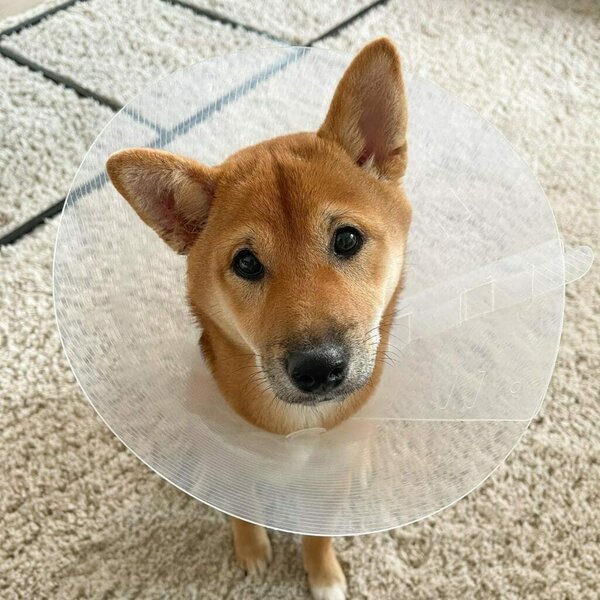
When Should I Take My Dog To The Vet For An Ear Infection?
You should take your dog to the vet for a proper medical diagnosis if the pooch’s ear infection fails to clear up within one to two days after administering either of the home remedies explained above.
When it comes to dog ear infections, quick and effective action is needed to ensure your furry friend’s comfort and to maintain the pooch’s quality of life. If the ear infection fails to go away immediately, this signifies the presence of an underlying health condition, such as an immune system disorder.
Continuing to administer home remedies for ear infections without any visible sign of recovery will cause the infection to worsen, and this can cause lasting damage to the pooch’s ears.
You don’t necessarily need to wait a day or two before scheduling a visit to the vet for your dog’s ear infection. And medical attention is needed quicker if you notice advanced symptoms of canine ear infections, such as:
- Head tilting and vigorous head shaking
- Obvious signs of pain and discomfort
- Refusal to let you touch and examine its ears
What Do Vets Give Dogs For Ear Infections?
The treatment that’ll be prescribed by a vet to tackle a dog’s ear infection varies, and it is majorly influenced by the underlying cause of the infection.
Typically, most vets will start off by cleaning the infected ear using a medicated ear cleanser before proceeding to recommend any of the ear infection treatments outlined below:
Antibiotics
Medicated ear drops or tablets containing antibiotics are commonly prescribed to help clear itching and reduce the inflammation associated with dog ear infections.
However, antibiotics are more of a temporary measure, and they are mainly effective at treating symptoms associated with dog ear infections.
Topical Medications
Most topical medications contain a combination of antibiotics, antifungal drugs, and glucocorticoids that are effective at combating canine ear infections. And depending on your vet’s diagnosis, a suitable topical medication is usually prescribed to treat your pooch’s ear infection.
Surgery
In some cases of chronic ear infections, an infected dog may require surgery to treat an underlying medical condition and effectively get rid of the dog’s ear infections.
Surgery is typically the last resort when a pooch fails to respond to medical treatments for ear infections or when the pooch’s outer ear infection degenerates into a middle or inner ear infection.
How Much Do Vets Charge For Ear Infections?
The cost of getting your dog’s ear infection treated varies greatly, and it is mainly influenced by the underlying cause of the infection as well as the stage of progression of the infection.
Outer ear infections caused by ear mites, bacteria, and yeast are typically easier to treat, and vets generally charge between $50 to $300, depending on the peculiarities of each individual case.
However, once the outer ear infection is allowed to degenerate into an inner ear infection, surgery is usually needed to correct the condition, and this can lead to medical bills running into thousands of dollars.
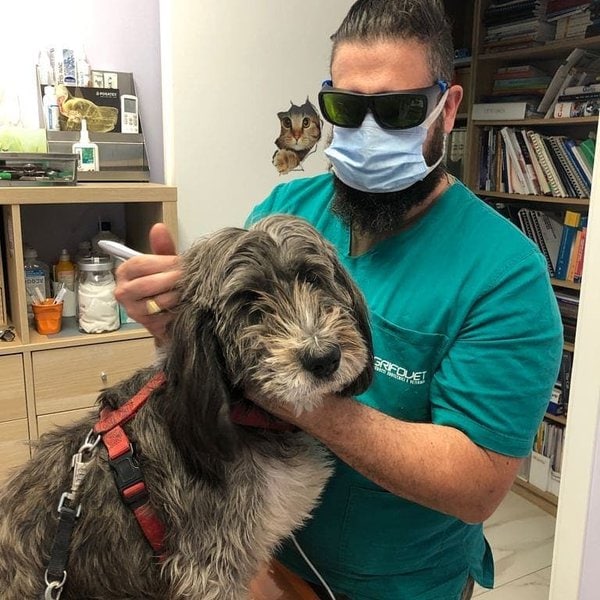
What Happens If Dog Ear Infection Goes Untreated?
Possible complications of failing to treat a dog’s ear infection includes a permanent loss or alteration of balance while walking, complete damage to the pooch’s eardrums, which typically results in deafness and severe pain.
Loss Of Balance
Functions of the canine ear aren’t limited to just receiving sounds, but the ear is an important organ when it comes to maintaining a pooch’s body balance and equilibrium.
Consequently, failure to treat an infection of a pooch’s ears can degenerate into an internal ear infection, and this can seriously mess up the dog’s sense of balance.
This loss of balance typically makes it difficult for the affected dog to walk properly, and you may observe the pooch leaning, rolling, falling or even walking in circles around the affected area.
And if both ears are infected, the pooch will tend to swing its head from side to side, thereby making it difficult to stay on its feet.
Damage To The Pooch’s Eardrums
Dog ear infections that are left untreated will eventually find their way from the external regions of the ear to the more sensitive middle and inner parts of the pooch’s ear.
Ear infections that make their way to the middle region of a dog’s ear are typically termed otitis media, while those that spread to the inner regions of the pooch’s ear are known as otitis interna.
Allowing an ear infection to spread and come in contact with a dog’s eardrums is quite dangerous. And apart from potentially rupturing the pooch’s eardrums, otitis media and otitis interna can also lead to serious medical conditions, such as:
- Facial paralysis
- Horner’s syndrome, and
- Keratoconjunctivitis sicca (commonly known as dry eye).
Intense Pain
Apart from the potential physical damages of leaving a dog’s ear infection untreated, you should also think about the great deal of pain the pooch will be suffering from while the infection rages on.
Dog ear infections can be extremely painful, and failure to apply the necessary medication to relieve the pooch’s pain, and effectively cure the infection will only make the symptoms worse.
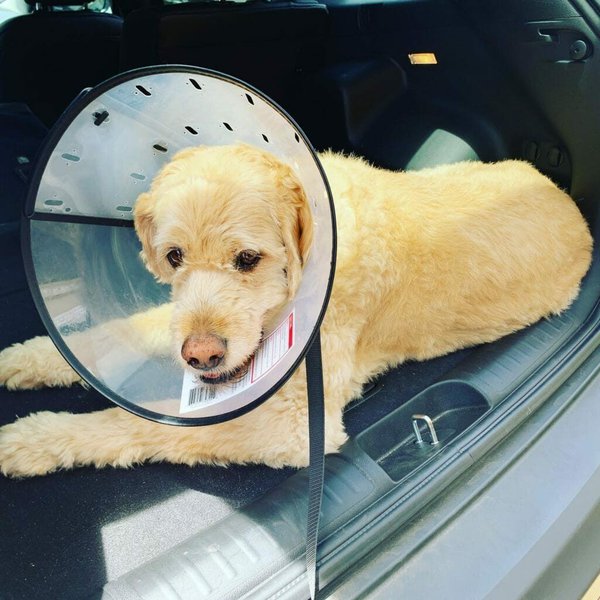
How Do I Know If My Dog’s Ear Is Infected?
You can tell that your dog is suffering from an ear infection if you notice symptoms such as excessive scratching of the ear, awkward head shaking, reddening and inflammation of the ear canal, and an unusual discharge or smell from the ear.
That said, knowledge of what a healthy, uninfected dog ear looks and smells like, is key to early diagnosis of canine ear infections. And we’re now going to examine the differences between a healthy canine ear, and one that is at any of the stages of an infection.
What Does A Dog Ear Infection Look And Smell Like?
A normal dog ear typically has a pale pink color, and is visibly clean, with no signs of inflammation or reddening. And, bar the faint smell of wax, healthy dog ears are typically odorless and dry to the touch.
A deviation from the normal pink color of the ear canal and an increase in a dog’s head shaking typically suggest the presence of dirt and debris or wax build-up. And the pooch is due for an ear-cleaning exercise at this point.
At the stage that a dog is due for ear cleaning, you may also notice the presence of brown, dirt like stuff or black, sticky gunk.
However, if you notice any of the following:
- Redness and inflammation of a pooch’s ears
- An offensive yeasty smell coming from the doggie’s ears
- Frequent and vigorous head shaking by the pooch
- Formation of scabs in the ears and on the sides of the pooch’s face
- Visible signs of pain from the dog
- Fluid discharge from the doggie’s ears
Then, the dog in question is most likely suffering from an ear infection. And immediate medical attention is needed to prevent the infection from degenerating into something worse.
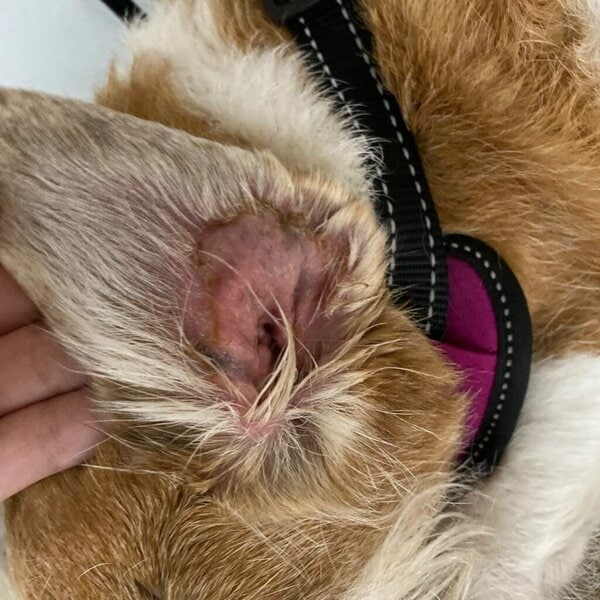
What Can I Clean My Dog’s Ears Out With?
Ear cleaning is an important part of a dog’s grooming needs, and it is also vital for managing canine ear infections. Hence, it is recommended that you clean your dog’s ear out with a vet-approved medical ear cleaner, soft wipes or cloth, and treats to reward your pooch.
Apart from the use of a vet-recommended ear cleaner, there are several other alternatives to cleaning your dog’s ears, one of which is warm water soaked in cotton wool balls. Avoid using Q-Tip swabs, as these will only push the debris deeper into the pooch’s ears.
Homemade dog ear cleaners are also easy to make, and you can quickly formulate one by mixing one-part white vinegar with two parts warm water.
Why Should You Clean Out Your Dog’s Ears?
One very good preventive measure against the various forms of ear infections that dogs are prone to is regular cleaning of the pooch’s ears.
The structure of a dog’s ear is such that dirt and debris can be easily trapped deep within the pooch’s ears, and difficult for the pooch to expel without assistance. Consequently, external assistance in the form of ear cleanings is needed to get rid of debris and dirt.
However, over-cleaning can lead to an irritation of the ear canal and subsequent ear infections; Hence, pooches with naturally clean ears may never need to get their ears cleaned.
How To Clean Out A Dog’s Ears?
The process of cleaning a dog’s ears is pretty straightforward, and this can be achieved by following the steps outlined below:
- Tilt the dog’s ear downward and squirt the vet-recommended ear cleanser into the pooch’s ear canal.
- Cover the dog’s ear with the flap, and gently massage around the base of the ear; Doing this will spread the cleanser, and subsequently soften debris located inside the dog’s ear.
- Once you’re done massaging, allow your pooch to shake its head to get rid of the cleanser and softened debris.
- Gently wipe off remnants of the cleanser and debris with soft wipes, while taking care not to drive debris any deeper.
As such, we recommend using Glandex Dog Wipes For Pets that can help with the cleaning and deodorizing processes for proper hygiene. Discard the used wipes right away when the job is done. It is that easy!
You should also pay attention to your dog’s reactions while cleaning its ears. And if, at any stage of cleaning the pooch’s ears, you notice signs of pain, you shouldn’t hesitate to consult your vet.
How Often Should I Clean My Dog’s Infected Ears?
The general recommendation is that dogs with healthy ears get cleaned once a month. But pooches with ear infections, and those with a history of this medical condition typically require more attention.
The length and frequency of ear cleaning for a pooch with an infected ear varies, and it mostly depends on the severity of the condition, the nature of the dog in question, as well as possible physical changes to the ear caused by the infection.
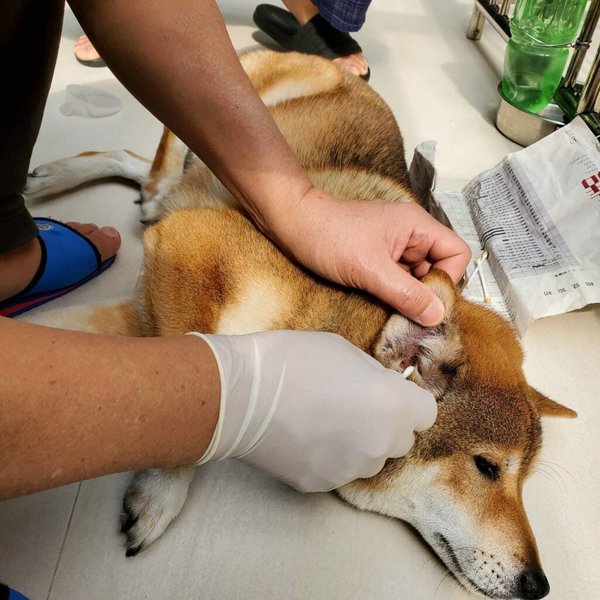
Can A Dog’s Diet Cause Ear Infections?
Yes, diet can also play a major role in causing ear infections in dogs.
Some pooches have sensitive stomachs, and most doggies are allergic to, at least, one food substance.
Consequently, feeding a dog with food substances that it is allergic to, typically causes an inflammation of the stomach and intestines. And this inflammation, in turn, encourages the overgrowth of bacteria and yeast in the intestines.
Bacteria and yeast caused by this inflammation then spread around the dog’s body, and they eventually find their way to the pooch’s ears, where they cause varying degrees of infections.
Other Causes Of Dog Ear Infections
Apart from a dog’s diet and food allergies, there are several other factors that may be responsible for canine ear infections. And some of the most common causes include:
Ear Mites
Parasitic ear mites are commonly found on dogs, and their actions in and around a pooch’s ears may lead to irritation, and the development of an ear infection.
Presence Of Foreign Objects In The Dog’s Ear
Dog ears tend to come in contact with insects, grass seeds, bugs, debris and foxtails, among others. And this is when you observe the pooch vigorously shaking its head in an attempt to dislodge the foreign object.
If, however, the pooch is unsuccessful with its attempts to get rid of the foreign object, its ears usually become irritated, thereby resulting in a bacterial infection.
Existing Injuries To The Ear
If not properly treated, injuries to a dog’s ears either through domestic accidents or fights with other dogs can fester, and degenerate into ear infections requiring professional medical attention.
Excessive Cleaning Of The Dog’s Ear
Understandably, you may have good intentions by wanting to regularly clean your dog’s ears. But cleaning your pooch’s ear without reasonable cause, and at odd or frequent intervals can cause irritation of the ear canal, and subsequent development of an ear infection.
Physical Anatomy
One commonly overlooked factor that can also cause ear infections in dogs is the way the pooch’s ear is shaped.
Dogs with long ear flaps find it easier to trap debris and moisture, thereby placing them at a higher risk of suffering ear infections.
Additionally, long ear flaps typically have restricted airflow, and the ear canal is a dark, moist environment; This is an ideal environment for excessive yeast growth, and the eventual outcome is an ear infection.

What Is The Best Dog Food For Dogs With Chronic Ear Infections?
The ideal food for dogs with chronic ear infections is a yeast-free diet with ingredients that boost the pooch’s immune system, thereby strengthening the dog’s body to fight against infection-causing yeast.
Familiarize Yourself With The Dog’s Food Allergies
We’ve stated earlier how dogs with food allergies are particularly prone to suffering from chronic ear infections.
Consequently, working closely with a vet or adopting an elimination diet to gain info on food substances the pooch is allergic to, and stopping the inclusion of such ingredients in the dog’s meals will work greatly to prevent the occurrence of chronic ear infections.
Similarly, a vet may prescribe a hypoallergenic diet for a dog with chronic ear infections to help limit the pooch’s potential exposure to allergens.
What Homemade Food Can You Give A Dog For Yeast Infections?
Yeast infestations are responsible for a significant number of canine ear infections. But by feeding your pooch a specially prepared homemade diet specifically designed to counter yeast infestation, you can alleviate symptoms of the dog’s ear infection.
The ideal anti-yeast diet for pooches with chronic ear infections should be devoid of food ingredients that are known to cause yeast infections. And these ingredients include all grains, buttermilk, cheese, cereals, potatoes, bread, sausage and bacon, just to mention a few.
Food substances that build up a pooch’s immune system, thereby helping to develop resistance against yeast infestations should make up the bulk of the homemade diet for a pooch with chronic ear infections. And these ingredients that help heal canine yeast infestations include:
- Animal protein sources such as chicken, fish, rabbit, and lamb
- Vegetables such as asparagus, broccoli, and dark leafy greens
- Green and yellow beans
- Plain yogurt
- Water
